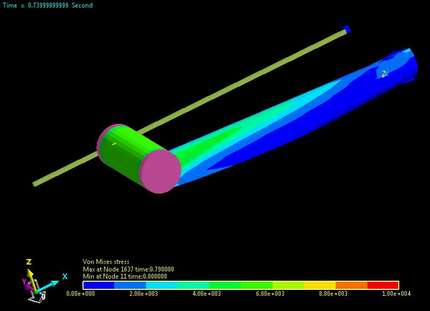FOR IMMEDIATE RELEASE
NASA Awards MotionPort with Small Business Innovative Research GrantMotionPort Will Assist NASA in Simulating the Deployment of Large Solar Arrays Aboard Spacecraft |

May 18, 2014, MotionPort, a distributor and developer of computer aided engineering software in St. George Utah, has received a NASA Small Business Innovation Research Phase I award of $125,000 to develop an application that will simulate deployable space structures, specifically roll-out solar arrays.
The work will assist NASA in increasing efficiency in stowing and deploying solar arrays of ever increasing size and reduce errors, time and the need for advanced knowledge to create system-level models. Winning this federal SBIR grant allows MotionPort to move ahead with their research and development with non-equity position dollars.
The Utah Science and Technology Research initiative’s (USTAR) Small Business Innovative Research (SBIR) and Small Business Technology Transfer (STTR) Assistance Center played a supportive role to MotionPort throughout the application process. Mary Cardon, director of the SBIR-STTR Assistance Center said this award demonstrates the kind of innovation that is happening throughout the state.
“This SBIR award is an outstanding accomplishment for Brant Ross and his team at MotionPort. It not only shines the spotlight on the great things happening at MotionPort, but also the state of Utah and Washington County,” said Cardon.

An early simulation of the tube structure used to deploy large solar arrays aboard spacecraft. The analysis was performed using RecurDyn multibody dynamics simulation.
Brant Ross, MotionPort business manager, moved to St. George from Ann Arbor, Michigan to be closer to family when he realized he could live anywhere and still serve his clients. Jill Ellis, USTAR South director, said having talented engineers like Ross in Southern Utah serves as a catalyst for economic growth in the region.
“We’re always excited to have gifted engineers like Brant relocating to our area,” said Ellis. “Our economic development professionals have worked hard to develop first class digital communication and access to airports a reality so rocket scientists can indeed locate their home base in St. George, Utah.”
MotionPort simulates mechanical systems that are in motion. Brant Ross, MotionPort business manager participated in a two-day workshop with NASA Glenn Research Center in the summer of 2012 where participants were invited to test drive MotionPort’s software. The software, RecurDyn, specializes on multi-body dynamics and multi-physics solutions. During the workshop, Ross was able to focus on the simulation and deployment of solar arrays in space.
Ross said NASA has used roll-out solar arrays before in spacecraft such as the Hubble Space Telescope, but now they are interested in building deployable solar arrays the size of a football field on each side of a spacecraft. The difficulty lies in finding a way to stow the panels on the launch vehicle so they are compact and can endure the forces and accelerations of launch. Thin tubes with a slit along the bottom can be pulled into a flat shape and can roll-up with the solar blanket (holding the solar cells) around a tube at the end of that section of the array. The result is a large section of the array becomes a compact cylindrical package for stowing.
“The tube shape is going to provide much better structural support than when things are flattened out,” said Ross. “Just like a piece of paper, it’s very flexible, and so are these tubes when we flatten them out. But when they return back to their cylindrical shape, they’re much better for supporting that solar blanket. We proved to them (NASA) that we could simulate the rolling up of the tube and also the deployment. We could also predict how much torque was available for the solar array to want to unroll itself, which is a key design element. That got their interest and they actually purchased a copy of the RecurDyn software.”
Though NASA is currently looking at football field sized solar arrays, they want to go even bigger in the future.
“If the solar arrays get bigger and bigger, the ability to do any kind of physical testing will be much more difficult and expensive because they are flimsy and can’t hold themselves up in normal gravity,” said Ross.
When applying for the SBIR NASA grant, Ross knew that he needed to partner with an experienced organization that could assist him through the application process and make sure he was on track.
“I had never written a proposal for an SBIR or even been a part of anybody else writing one,” said Ross. “I contacted the USTAR office in St. George and they were able to help me a great deal. In addition to ensuring I was following the rules, they also read over my proposal and pointed out where I needed to make certain things clearer, and that was essential.”
While MotionPort is currently focusing on its Phase I efforts of solar array deployment, the company isn’t far off from being able to work on other types of deployable structures. After completing Phase I, Ross said they intend to apply for a Phase II. The company also anticipates that the application will be something to resell to NASA contractors and other space agencies.
This article was written by Elenor Heyborne at the Utah Science Technology and Research Initiative
Related Coverage:
More Information:
- Learn about RecurDyn/FFlex (Full Flex) which is used for these simulations.
